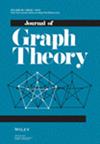求助PDF
{"title":"超图反拉姆齐定理","authors":"Xizhi Liu, Jialei Song","doi":"10.1002/jgt.23204","DOIUrl":null,"url":null,"abstract":"<div>\n \n <p>The anti-Ramsey number <span></span><math>\n \n <semantics>\n \n <mrow>\n <mtext>ar</mtext>\n \n <mrow>\n \n <mo>(</mo>\n \n <mrow>\n \n <mi>n</mi>\n \n <mo>,</mo>\n \n <mi>F</mi>\n </mrow>\n \n <mo>)</mo>\n </mrow>\n </mrow>\n <annotation>\n $\\text{ar}(n,F)$\n</annotation>\n </semantics>\n </math> of an <span></span><math>\n \n <semantics>\n \n <mrow>\n <mi>r</mi>\n </mrow>\n <annotation>\n $r$\n</annotation>\n </semantics>\n </math>-graph <span></span><math>\n \n <semantics>\n \n <mrow>\n <mi>F</mi>\n </mrow>\n <annotation>\n $F$\n</annotation>\n </semantics>\n </math> is the minimum number of colors needed to color the complete <span></span><math>\n \n <semantics>\n \n <mrow>\n <mi>n</mi>\n </mrow>\n <annotation>\n $n$\n</annotation>\n </semantics>\n </math>-vertex <span></span><math>\n \n <semantics>\n \n <mrow>\n <mi>r</mi>\n </mrow>\n <annotation>\n $r$\n</annotation>\n </semantics>\n </math>-graph to ensure the existence of a rainbow copy of <span></span><math>\n \n <semantics>\n \n <mrow>\n <mi>F</mi>\n </mrow>\n <annotation>\n $F$\n</annotation>\n </semantics>\n </math>. We establish a removal-type result for the anti-Ramsey problem of <span></span><math>\n \n <semantics>\n \n <mrow>\n <mi>F</mi>\n </mrow>\n <annotation>\n $F$\n</annotation>\n </semantics>\n </math> when <span></span><math>\n \n <semantics>\n \n <mrow>\n <mi>F</mi>\n </mrow>\n <annotation>\n $F$\n</annotation>\n </semantics>\n </math> is the expansion of a hypergraph with a smaller uniformity. We present two applications of this result. First, we refine the general bound <span></span><math>\n \n <semantics>\n \n <mrow>\n <mtext>ar</mtext>\n \n <mrow>\n \n <mo>(</mo>\n \n <mrow>\n \n <mi>n</mi>\n \n <mo>,</mo>\n \n <mi>F</mi>\n </mrow>\n \n <mo>)</mo>\n </mrow>\n \n <mo>=</mo>\n \n <mtext>ex</mtext>\n \n <mrow>\n \n <mo>(</mo>\n \n <mrow>\n \n <mi>n</mi>\n \n <mo>,</mo>\n \n <msub>\n \n <mi>F</mi>\n \n <mo>−</mo>\n </msub>\n </mrow>\n \n <mo>)</mo>\n </mrow>\n \n <mo>+</mo>\n \n <mi>o</mi>\n \n <mrow>\n \n <mo>(</mo>\n \n <msup>\n \n <mi>n</mi>\n \n <mi>r</mi>\n </msup>\n \n <mo>)</mo>\n </mrow>\n </mrow>\n <annotation>\n $\\text{ar}(n,F)=\\text{ex}(n,{F}_{-})+o({n}^{r})$\n</annotation>\n </semantics>\n </math> proved by Erdős–Simonovits–Sós, where <span></span><math>\n \n <semantics>\n \n <mrow>\n <msub>\n \n <mi>F</mi>\n \n <mo>−</mo>\n </msub>\n </mrow>\n <annotation>\n ${F}_{-}$\n</annotation>\n </semantics>\n </math> denotes the family of <span></span><math>\n \n <semantics>\n \n <mrow>\n <mi>r</mi>\n </mrow>\n <annotation>\n $r$\n</annotation>\n </semantics>\n </math>-graphs obtained from <span></span><math>\n \n <semantics>\n \n <mrow>\n <mi>F</mi>\n </mrow>\n <annotation>\n $F$\n</annotation>\n </semantics>\n </math> by removing one edge. Second, we determine the exact value of <span></span><math>\n \n <semantics>\n \n <mrow>\n <mtext>ar</mtext>\n \n <mrow>\n \n <mo>(</mo>\n \n <mrow>\n \n <mi>n</mi>\n \n <mo>,</mo>\n \n <mi>F</mi>\n </mrow>\n \n <mo>)</mo>\n </mrow>\n </mrow>\n <annotation>\n $\\text{ar}(n,F)$\n</annotation>\n </semantics>\n </math> for large <span></span><math>\n \n <semantics>\n \n <mrow>\n <mi>n</mi>\n </mrow>\n <annotation>\n $n$\n</annotation>\n </semantics>\n </math> in cases where <span></span><math>\n \n <semantics>\n \n <mrow>\n <mi>F</mi>\n </mrow>\n <annotation>\n $F$\n</annotation>\n </semantics>\n </math> is the expansion of a specific class of graphs. This extends results of Erdős–Simonovits–Sós on complete graphs to the realm of hypergraphs.</p>\n </div>","PeriodicalId":16014,"journal":{"name":"Journal of Graph Theory","volume":"108 4","pages":"808-816"},"PeriodicalIF":1.0000,"publicationDate":"2024-12-08","publicationTypes":"Journal Article","fieldsOfStudy":null,"isOpenAccess":false,"openAccessPdf":"","citationCount":"0","resultStr":"{\"title\":\"Hypergraph Anti-Ramsey Theorems\",\"authors\":\"Xizhi Liu, Jialei Song\",\"doi\":\"10.1002/jgt.23204\",\"DOIUrl\":null,\"url\":null,\"abstract\":\"<div>\\n \\n <p>The anti-Ramsey number <span></span><math>\\n \\n <semantics>\\n \\n <mrow>\\n <mtext>ar</mtext>\\n \\n <mrow>\\n \\n <mo>(</mo>\\n \\n <mrow>\\n \\n <mi>n</mi>\\n \\n <mo>,</mo>\\n \\n <mi>F</mi>\\n </mrow>\\n \\n <mo>)</mo>\\n </mrow>\\n </mrow>\\n <annotation>\\n $\\\\text{ar}(n,F)$\\n</annotation>\\n </semantics>\\n </math> of an <span></span><math>\\n \\n <semantics>\\n \\n <mrow>\\n <mi>r</mi>\\n </mrow>\\n <annotation>\\n $r$\\n</annotation>\\n </semantics>\\n </math>-graph <span></span><math>\\n \\n <semantics>\\n \\n <mrow>\\n <mi>F</mi>\\n </mrow>\\n <annotation>\\n $F$\\n</annotation>\\n </semantics>\\n </math> is the minimum number of colors needed to color the complete <span></span><math>\\n \\n <semantics>\\n \\n <mrow>\\n <mi>n</mi>\\n </mrow>\\n <annotation>\\n $n$\\n</annotation>\\n </semantics>\\n </math>-vertex <span></span><math>\\n \\n <semantics>\\n \\n <mrow>\\n <mi>r</mi>\\n </mrow>\\n <annotation>\\n $r$\\n</annotation>\\n </semantics>\\n </math>-graph to ensure the existence of a rainbow copy of <span></span><math>\\n \\n <semantics>\\n \\n <mrow>\\n <mi>F</mi>\\n </mrow>\\n <annotation>\\n $F$\\n</annotation>\\n </semantics>\\n </math>. We establish a removal-type result for the anti-Ramsey problem of <span></span><math>\\n \\n <semantics>\\n \\n <mrow>\\n <mi>F</mi>\\n </mrow>\\n <annotation>\\n $F$\\n</annotation>\\n </semantics>\\n </math> when <span></span><math>\\n \\n <semantics>\\n \\n <mrow>\\n <mi>F</mi>\\n </mrow>\\n <annotation>\\n $F$\\n</annotation>\\n </semantics>\\n </math> is the expansion of a hypergraph with a smaller uniformity. We present two applications of this result. First, we refine the general bound <span></span><math>\\n \\n <semantics>\\n \\n <mrow>\\n <mtext>ar</mtext>\\n \\n <mrow>\\n \\n <mo>(</mo>\\n \\n <mrow>\\n \\n <mi>n</mi>\\n \\n <mo>,</mo>\\n \\n <mi>F</mi>\\n </mrow>\\n \\n <mo>)</mo>\\n </mrow>\\n \\n <mo>=</mo>\\n \\n <mtext>ex</mtext>\\n \\n <mrow>\\n \\n <mo>(</mo>\\n \\n <mrow>\\n \\n <mi>n</mi>\\n \\n <mo>,</mo>\\n \\n <msub>\\n \\n <mi>F</mi>\\n \\n <mo>−</mo>\\n </msub>\\n </mrow>\\n \\n <mo>)</mo>\\n </mrow>\\n \\n <mo>+</mo>\\n \\n <mi>o</mi>\\n \\n <mrow>\\n \\n <mo>(</mo>\\n \\n <msup>\\n \\n <mi>n</mi>\\n \\n <mi>r</mi>\\n </msup>\\n \\n <mo>)</mo>\\n </mrow>\\n </mrow>\\n <annotation>\\n $\\\\text{ar}(n,F)=\\\\text{ex}(n,{F}_{-})+o({n}^{r})$\\n</annotation>\\n </semantics>\\n </math> proved by Erdős–Simonovits–Sós, where <span></span><math>\\n \\n <semantics>\\n \\n <mrow>\\n <msub>\\n \\n <mi>F</mi>\\n \\n <mo>−</mo>\\n </msub>\\n </mrow>\\n <annotation>\\n ${F}_{-}$\\n</annotation>\\n </semantics>\\n </math> denotes the family of <span></span><math>\\n \\n <semantics>\\n \\n <mrow>\\n <mi>r</mi>\\n </mrow>\\n <annotation>\\n $r$\\n</annotation>\\n </semantics>\\n </math>-graphs obtained from <span></span><math>\\n \\n <semantics>\\n \\n <mrow>\\n <mi>F</mi>\\n </mrow>\\n <annotation>\\n $F$\\n</annotation>\\n </semantics>\\n </math> by removing one edge. Second, we determine the exact value of <span></span><math>\\n \\n <semantics>\\n \\n <mrow>\\n <mtext>ar</mtext>\\n \\n <mrow>\\n \\n <mo>(</mo>\\n \\n <mrow>\\n \\n <mi>n</mi>\\n \\n <mo>,</mo>\\n \\n <mi>F</mi>\\n </mrow>\\n \\n <mo>)</mo>\\n </mrow>\\n </mrow>\\n <annotation>\\n $\\\\text{ar}(n,F)$\\n</annotation>\\n </semantics>\\n </math> for large <span></span><math>\\n \\n <semantics>\\n \\n <mrow>\\n <mi>n</mi>\\n </mrow>\\n <annotation>\\n $n$\\n</annotation>\\n </semantics>\\n </math> in cases where <span></span><math>\\n \\n <semantics>\\n \\n <mrow>\\n <mi>F</mi>\\n </mrow>\\n <annotation>\\n $F$\\n</annotation>\\n </semantics>\\n </math> is the expansion of a specific class of graphs. This extends results of Erdős–Simonovits–Sós on complete graphs to the realm of hypergraphs.</p>\\n </div>\",\"PeriodicalId\":16014,\"journal\":{\"name\":\"Journal of Graph Theory\",\"volume\":\"108 4\",\"pages\":\"808-816\"},\"PeriodicalIF\":1.0000,\"publicationDate\":\"2024-12-08\",\"publicationTypes\":\"Journal Article\",\"fieldsOfStudy\":null,\"isOpenAccess\":false,\"openAccessPdf\":\"\",\"citationCount\":\"0\",\"resultStr\":null,\"platform\":\"Semanticscholar\",\"paperid\":null,\"PeriodicalName\":\"Journal of Graph Theory\",\"FirstCategoryId\":\"100\",\"ListUrlMain\":\"https://onlinelibrary.wiley.com/doi/10.1002/jgt.23204\",\"RegionNum\":3,\"RegionCategory\":\"数学\",\"ArticlePicture\":[],\"TitleCN\":null,\"AbstractTextCN\":null,\"PMCID\":null,\"EPubDate\":\"\",\"PubModel\":\"\",\"JCR\":\"Q2\",\"JCRName\":\"MATHEMATICS\",\"Score\":null,\"Total\":0}","platform":"Semanticscholar","paperid":null,"PeriodicalName":"Journal of Graph Theory","FirstCategoryId":"100","ListUrlMain":"https://onlinelibrary.wiley.com/doi/10.1002/jgt.23204","RegionNum":3,"RegionCategory":"数学","ArticlePicture":[],"TitleCN":null,"AbstractTextCN":null,"PMCID":null,"EPubDate":"","PubModel":"","JCR":"Q2","JCRName":"MATHEMATICS","Score":null,"Total":0}
引用次数: 0
引用
批量引用

 求助内容:
求助内容: 应助结果提醒方式:
应助结果提醒方式:


